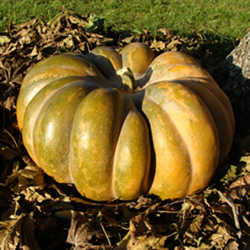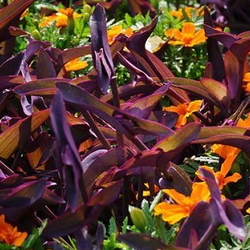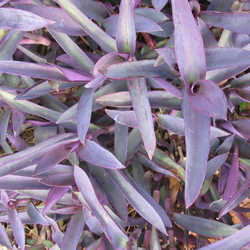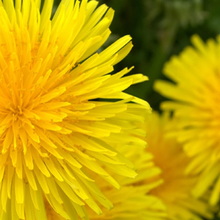Purple Heart, or Purple Queen (Tradescantia pallida) is usually found as a houseplant north of zone 8. It enjoys outdoor living here only in the summers as a bedding plant or on the deck in filtered sun. It is thus especially pleasant as a striking, majestic accent in such seasonal containers here in northern climes.
Knowing its potential for beauty and drama, it dismayed me to witness what appeared to be a Purple Heart breathing its last gasp when I began my new "old" job last winter. (I had been away for a year or so, and come to think of it, that potted Purple Heart probably was once mine, anyway.)
No matter. It was time to take action before further etiolation (light-starvation) weakened the plant to death.
The first thing I did was to snip off three stem cuttings just in case the plant died before I could devise a plan to rescue it. The cuttings rooted well in water. They were then potted in a blue Tupperware cup fashioned with drainage holes.
Good. Nice and purple. Maybe I could do even more to help, I thought. After requesting permission, I removed the sick Purple Heart plant altogether for a hospital stay at my house in February.
The soil in its pot was rock-hard, so the old plant got a dunk by immersion. Then the plant was temporarily placed in a sunny window for light therapy.
Keeping Purple Heart in the old soil was not an option, however. The truth was that the plant had to undergo surgery. After that, the root ball would be discarded. Drastic, but life-saving to the plant.
(I had done this before with plants for which there was no other rescue option besides massive stem cuttings.)

|
In reality, the whole operation yielded only two small jars of stem cuttings. But since I had potted up their older brother a few weeks before, perhaps a new plant could be made from the new stem cuttings PLUS their older brother, all in the same new pot. All that was needed was time and TLC. It was worth a shot. |
|||||
 |
 |
||||
|
After just a few days of window and fluorescent light, the stem cuttings began to deepen in color. YES! The stem cuttings rooted quickly. Within two weeks, it was time to pot them up.  
I chose orchid soil, knowing the chunks of bark would give the young plants great drainage. In no time at all, the new little plants were well on their way to catching up in growth to their older sibling. The plan was working! All that remained was more time to grow before the final, dramatic step ...
|
|||||



















